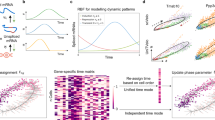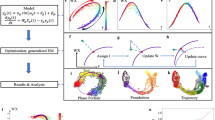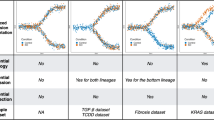Abstract
RNA velocity has opened up new ways of studying cellular differentiation in single-cell RNA-sequencing data. It describes the rate of gene expression change for an individual gene at a given time point based on the ratio of its spliced and unspliced messenger RNA (mRNA). However, errors in velocity estimates arise if the central assumptions of a common splicing rate and the observation of the full splicing dynamics with steady-state mRNA levels are violated. Here we present scVelo, a method that overcomes these limitations by solving the full transcriptional dynamics of splicing kinetics using a likelihood-based dynamical model. This generalizes RNA velocity to systems with transient cell states, which are common in development and in response to perturbations. We apply scVelo to disentangling subpopulation kinetics in neurogenesis and pancreatic endocrinogenesis. We infer gene-specific rates of transcription, splicing and degradation, recover each cell’s position in the underlying differentiation processes and detect putative driver genes. scVelo will facilitate the study of lineage decisions and gene regulation.
This is a preview of subscription content, access via your institution
Access options
Access Nature and 54 other Nature Portfolio journals
Get Nature+, our best-value online-access subscription
$29.99 / 30 days
cancel any time
Subscribe to this journal
Receive 12 print issues and online access
$209.00 per year
only $17.42 per issue
Buy this article
- Purchase on Springer Link
- Instant access to full article PDF
Prices may be subject to local taxes which are calculated during checkout



Similar content being viewed by others
Data availability
The data sets analyzed in this paper are publicly available and published. The annotated data, results and Python implementation are available at https://scvelo.org. The raw data set of hippocampal dentate gyrus neurogenesis is available in the National Center for Biotechnology Informationʼs Gene Expression Omnibus repository under accession number GSE95753. We included samples from two experimental time points: P12 and P35. The raw data set of pancreatic endocrinogenesis has been deposited under accession number GSE132188. We included samples from the last experimental time point: E15.5.
Code availability
The results reported in this paper and our Python implementation are available at https://scvelo.org.
References
Griffiths, J. A. et al. Using single-cell genomics to understand developmental processes and cell fate decisions. Mol. Syst. Biol. 14, e8046 (2018).
Kulkarni, A. et al. Beyond bulk: a review of single cell transcriptomics methodologies and applications. Curr. Opin. Biotechnol. 58, 129–136 (2019).
Haghverdi, L. et al. Diffusion pseudotime robustly reconstructs lineage branching. Nat. Methods 13, 845–848 (2016).
Setty, M. et al. Wishbone identifies bifurcating developmental trajectories from single-cell data. Nat. Biotechnol. 34, 637–645 (2016).
Trapnell, C. et al. The dynamics and regulators of cell fate decisions are revealed by pseudotem- poral ordering of single cells. Nat. Biotechnol. 32, 381–386 (2014).
Cannoodt, R. et al. Computational methods for trajectory inference from single-cell transcriptomics. Eur. J. Immunol. 46, 2496–2506 (2016).
Wolf, F. A. et al. PAGA: Graph abstraction reconciles clustering with trajectory inference through a topology preserving map of single cells. Genome Biol. 20, 59 (2019).
Saelens, W. et al. A comparison of single-cell trajectory inference methods. Nat. Biotechnol. 37, 547 (2019).
Weinreb, C. et al. Fundamental limits on dynamic inference from single-cell snapshots. Proc. Natl Acad. Sci. USA 115, E2467–E2476 (2018).
Tritschler, S. et al. Concepts and limitations for learning developmental trajectories from single cell genomics. Development 146, dev170506 (2019).
Junker, J. P. et al. Massively parallel clonal analysis using CRISPR/Cas9 induced genetic scars. Preprint at https://www.biorxiv.org/content/10.1101/056499v2 (2017).
Frieda, K. L. et al. Synthetic recording and in situ readout of lineage information in single cells. Nature 541, 107–111 (2017).
Spanjaard, B. et al. Simultaneous lineage tracing and cell-type identification using CRISPR–Cas9- induced genetic scars. Nat. Biotechnol. 36, 469–473 (2018).
Raj, B. et al. Simultaneous single-cell profiling of lineages and cell types in the vertebrate brain. Nat. Biotechnol. 36, 442–450 (2018).
Alemany, A. et al. Whole-organism clone tracing using single-cell sequencing. Nature 556, 108–112 (2018).
Kester, L. & van Oudenaarden, A. Single-cell transcriptomics meets lineage tracing. Cell Stem Cell 23, 166–179 (2018).
Ludwig, L. S. et al. Lineage tracing in humans enabled by mitochondrial mutations and single-cell genomics. Cell 176, 1325–1339.e22 (2019).
La Manno, G. et al. RNA velocity of single cells. Nature 560, 494 (2018).
Hochgerner, H. et al. Conserved properties of dentate gyrus neurogenesis across postnatal development revealed by single-cell RNA sequencing. Nat. Neurosci. 21, 290–299 (2018).
Bastidas-Ponce, A. et al. Comprehensive single cell mRNA profiling reveals a detailed roadmap for pancreatic endocrinogenesis. Development 146, dev173849 (2019).
Wolf, F. A. et al. SCANPY: Large-scale single-cell gene expression data analysis. Genome Biol. 19, 15 (2018).
Hunter, J. D. Matplotlib: A 2D graphics environment. Comput. Sci. Eng. 9, 90–95 (2007).
McInnes, L. & Healy, J. UMAP: Uniform manifold approximation and projection for dimension reduction. Preprint at https://arxiv.org/abs/1802.03426 (2018).
Duric, V. et al. Altered expression of synapse and glutamate related genes in post-mortem hippocampus of depressed subjects. Int. J. Neuropsychopharmacol. 16, 69–82 (2013).
Ryley Parrish, R. et al. Status epilepticus triggers early and late alterations in brain-derived neurotrophic factor and NMDA glutamate receptor Grin2b DNA methylation levels in the hippocampus. Neuroscience 248, 602–619 (2013).
Artegiani, B. et al. A single-cell RNA sequencing study reveals cellular and molecular dynamics of the hippocampal neurogenic niche. Cell Rep. 21, 3271–3284 (2017).
Seo, J.-S. et al. Transcriptome analyses of chronic traumatic encephalopathy show alterations in protein phosphatase expression associated with tauopathy. Exp. Mol. Med. 49, e333–e333 (2017).
Byrnes, L. E. et al. Lineage dynamics of murine pancreatic development at single-cell resolution. Nat. Commun. 9, 1–17 (2018).
Macosko, E. Z. et al. Highly parallel genome-wide expression profiling of individual cells using nanoliter droplets. Cell 161, 1202–1214 (2015).
Bechard, M. E. et al. Precommitment low-level Neurog3 expression defines a long-lived mitotic endocrine-biased progenitor pool that drives production of endocrine-committed cells. Genes Dev. 30, 1852–1865 (2016).
Krentz, N. A. J. et al. Single-cell transcriptome profiling of mouse and hESC-derived pancreatic progenitors. Stem Cell Rep. 11, 1551–1564 (2018).
Ramond, C. et al. Understanding human fetal pancreas development using subpopulation sorting, RNA sequencing and single-cell profiling. Development 145, dev165480 (2018).
Yan, F.-F. et al. Congenital hyperinsulinism-associated ABCC8 mutations that cause defective trafficking of ATP-sensitive K+ channels. Diabetes 56, 2339–2348 (2007).
Liew, C. W. et al. Insulin regulates carboxypeptidase E by modulating translation initiation scaffolding protein eIF4G1 in pancreatic β cells. Proc. Natl Acad. Sci. USA 111, E2319–E2328 (2014).
Wasserfall, C. et al. Persistence of pancreatic insulin mRNA expression and proinsulin protein in type 1 diabetes pancreata. Cell Metab. 26, 568–575.e3 (2017).
Raj, A. & van Oudenaarden, A. Nature, nurture, or chance: stochastic gene expression and its consequences. Cell 135, 216–226 (2008).
Wilkinson, D. J. Stochastic modelling for quantitative description of heterogeneous biological systems. Nat. Rev. Genet. 10, 122–133 (2009).
Fröhlich, F. et al. Inference for stochastic chemical kinetics using moment equations and system size expansion. PLoS Comput. Biol. 12, e1005030 (2016).
Malkov, Y. A. & Yashunin, D. A. Efficient and robust approximate nearest neighbor search using Hierarchical Navigable Small World graphs. IEEE Trans. Pattern Anal. Mach. Intell. 42, 824–836 (2018).
Picelli, S. et al. Smart-seq2 for sensitive full-length transcriptome profiling in single cells. Nat. Methods 10, 1096–1098 (2013).
Moor, A. E. & Itzkovitz, S. Spatial transcriptomics: paving the way for tissue-level systems biology. Curr. Opin. Biotechnol. 46, 126–133 (2017).
Xia, C. et al. Spatial transcriptome profiling by MERFISH reveals subcellular RNA compartmentalization and cell cycle-dependent gene expression. Proc. Natl Acad. Sci. USA 116, 19490–19499 (2019).
Munsky, B. et al. Listening to the noise: random fluctuations reveal gene network parameters. Mol. Syst. Biol. 5, 318 (2009).
Gorin, G., Svensson, V. & Pachter, L. Protein velocity and acceleration from single-cell multiomics experiments. Genome Biol. 21, 39 (2020).
Erhard, F. et al. scSLAM-seq reveals core features of transcription dynamics in single cells. Nature 571, 419–423 (2019).
Qiu, X. et al. Mapping vector field of single cells. Preprint at https://www.biorxiv.org/content/10.1101/696724v1 (2019).
Fröhlich, F. et al. Scalable parameter estimation for genome-scale biochemical reaction networks. PLoS Comput. Biol. 13, e1005331 (2017).
Lotfollahi, M. et al. scGen predicts single-cell perturbation responses. Nat. Methods 16, 715–721 (2019).
Melsted, P. et al. Modular and efficient pre-processing of single-cell RNA-seq. Preprint at https://www.biorxiv.org/content/10.1101/673285v2 (2019).
Strunz, M. et al. Longitudinal single cell transcriptomics reveals Krt8+ alveolar epithelial progenitors in lung regeneration. Preprint at https://www.biorxiv.org/content/10.1101/705244v2 (2019).
Blondel, V. D. et al. Fast unfolding of communities in large networks. J. Stat. Mech. 2008, P10008 (2008).
Gu, G. et al. Global expression analysis of gene regulatory pathways during endocrine pancreatic development. Development 131, 165–179 (2004).
de Lichtenberg, K. H. et al. Notch controls multiple pancreatic cell fate regulators through direct hes1-mediated repression. Preprint at https://www.biorxiv.org/content/10.1101/336305v1 (2018).
Acknowledgements
We thank P. Kharchenko and S. Linnarsson for stimulating discussions, M. Luecken for valuable feedback on the manuscript and S. Tritschler for valuable feedback on the biological applications. This work was supported by BMBF grants (01IS18036A and 01IS18053A); by the German Research Foundation (DFG) within the Collaborative Research Centre 1243, Subproject A17; by the Helmholtz Association (sparse2big and ZT-I-0007); and by the Chan Zuckerberg Initiative DAF (182835). M.L. further acknowledges financial support by the DFG through the Graduate School of Quantitative Biosciences Munich (GSC 1006), by the Joachim Herz Stiftung Foundation and by the Bayer Foundation.
Author information
Authors and Affiliations
Contributions
V.B. designed and developed the method, implemented scVelo and analyzed the data. F.J.T. conceived the study with contributions from V.B. and F.A.W. V.B., F.A.W. and F.J.T. wrote the manuscript with contributions from the coauthors. S.P. contributed to developing scVelo. M.L. contributed to developing validation metrics. All authors read and approved the final manuscript.
Corresponding authors
Ethics declarations
Competing interests
F.A.W. is a full-time employee of Cellarity Inc.; the present work was carried out as an employee of Helmholtz Munich. F.J.T. reports receiving consulting fees from Roche Diagnostics GmbH and Cellarity Inc., and ownership interest in Cellarity, Inc.
Additional information
Publisher’s note Springer Nature remains neutral with regard to jurisdictional claims in published maps and institutional affiliations.
Supplementary information
Supplementary Information
Supplementary Figs. 1–13.
Rights and permissions
About this article
Cite this article
Bergen, V., Lange, M., Peidli, S. et al. Generalizing RNA velocity to transient cell states through dynamical modeling. Nat Biotechnol 38, 1408–1414 (2020). https://doi.org/10.1038/s41587-020-0591-3
Received:
Accepted:
Published:
Issue Date:
DOI: https://doi.org/10.1038/s41587-020-0591-3
This article is cited by
-
Biochemical and transcriptomic evaluation of a 3D lung organoid platform for pre-clinical testing of active substances targeting senescence
Respiratory Research (2024)
-
DeepVelo: deep learning extends RNA velocity to multi-lineage systems with cell-specific kinetics
Genome Biology (2024)
-
Single-cell transcriptomic analysis reveals tumor cell heterogeneity and immune microenvironment features of pituitary neuroendocrine tumors
Genome Medicine (2024)
-
FOXO1 reshapes neutrophils to aggravate acute brain damage and promote late depression after traumatic brain injury
Military Medical Research (2024)
-
Single-cell and spatial RNA sequencing reveal the spatiotemporal trajectories of fruit senescence
Nature Communications (2024)



